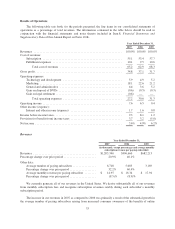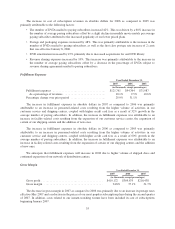NetFlix 2007 Annual Report Download - page 34
Download and view the complete annual report
Please find page 34 of the 2007 NetFlix annual report below. You can navigate through the pages in the report by either clicking on the pages listed below, or by using the keyword search tool below to find specific information within the annual report.Recent Developments
We believe that the DVD format, along with its high definition successor formats, including Blu-ray, will
continue to be the main vehicle for watching content in the home for the foreseeable future. We introduced a new
feature in January 2007 that allows subscribers to instantly watch movies and television series on their PCs. We
intend to broaden the distribution capability of this feature to multiple platforms over time, and, as a result, in
January 2008 we announced a development arrangement with LG Electronics. While the terms of this
arrangement have not been finalized, we anticipate developing, in conjunction with LG, a set-top box device that
will enable our instant-watching feature to be viewed directly through subscribers’ televisions.
In late 2006, Blockbuster launched its integrated store-based and online program, Total Access, whereby
Blockbuster online subscribers may return DVDs delivered to them from Blockbuster Online to Blockbuster
stores in exchange for an in-store rental. Total Access was aggressively priced and experienced rapid subscriber
growth and large operating losses in the first half of 2007. In the second half of 2007, Blockbuster adopted a new
competitive strategy which emphasized profitable growth. As part of this new strategy, Blockbuster reduced their
marketing spending and raised prices on Total Access, which we believe contributed to an acceleration in our
subscriber growth.
Critical Accounting Policies and Estimates
The preparation of consolidated financial statements in conformity with accounting principles generally
accepted in the United States requires estimates and assumptions that affect the reported amounts of assets and
liabilities, revenues and expenses and related disclosures of contingent assets and liabilities in our consolidated
financial statements and accompanying notes. The Securities and Exchange Commission (“SEC”) has defined a
company’s critical accounting policies as the ones that are most important to the portrayal of a company’s
financial condition and results of operations, and which require a company to make its most difficult and
subjective judgments. Based on this definition, we have identified the critical accounting policies and judgments
addressed below. Although we believe that our estimates, assumptions and judgments are reasonable, they are
based upon information presently available. Actual results may differ significantly from these estimates under
different assumptions, judgments or conditions.
Amortization of Content Library and Upfront Costs
We acquire content from studios and distributors through direct purchases, revenue sharing agreements or
license agreements. We acquire content for the purpose of rental to our subscribers and earning subscription
rental revenues, and, as such, we consider our content library to be a productive asset, and classify our content
library as a non-current asset. Additionally, in accordance with Statement of Financial Accounting Standards
(“SFAS”) No. 95, Statement of Cash Flows, we classify cash outflows for the acquisition of the content library,
net of changes in related accounts payable, as cash flows from investing activities on our consolidated statements
of cash flows. This is inclusive of any upfront non-refundable payments required under revenue sharing
agreements.
We amortize our DVDs, less estimated salvage value, on a “sum-of-the-months” accelerated basis over their
estimated useful lives. The useful life of the new-release DVDs and back-catalog DVDs is estimated to be 1 year
and 3 years, respectively. In estimating the useful life of our DVDs, we take into account library utilization as
well as an estimate for lost or damaged DVDs. Volume purchase discounts received from studios on the purchase
of titles are recorded as a reduction of DVD inventory when earned.
For those direct purchase DVDs that we estimate we will sell at the end of their useful lives, a salvage value
of $3.00 per DVD has been provided. For those DVDs that we do not expect to sell, no salvage value is provided.
We periodically evaluate the useful lives and salvage values of our DVDs.
29
























